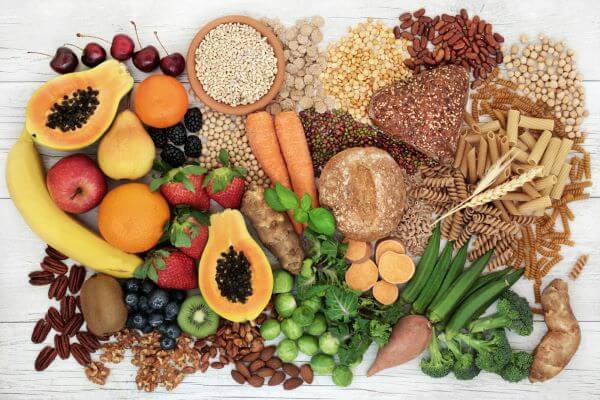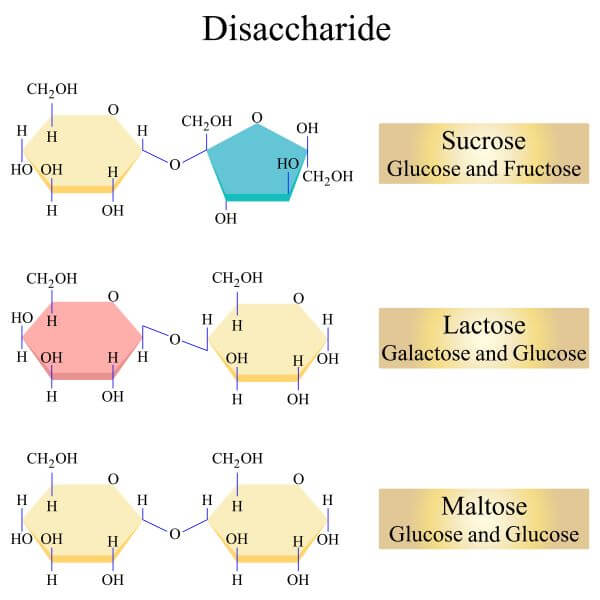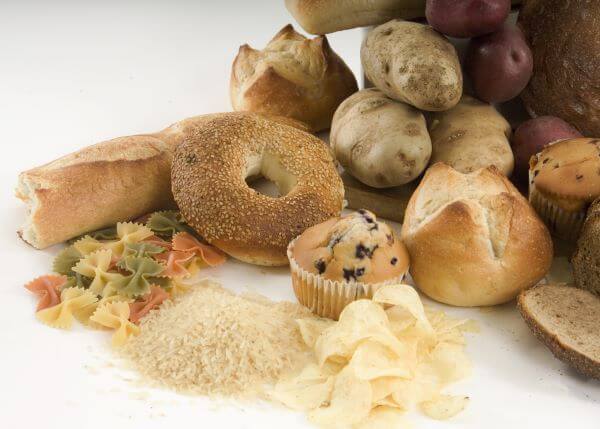Carbohydrates are thought to be the most abundant organic substances in nature. They can be broadly divided into two main groups; simple carbohydrates (or sugars) and complex carbohydrates (AKA starches).
Common examples of simple carbohydrates include glucose, fructose, galactose, sucrose, lactose, and maltose. Examples of complex carbohydrates include starch, glycogen, and cellulose.

What Are Carbohydrates?
Carbohydrates are a class of organic compounds mainly made up of carbon (C), oxygen (O), and hydrogen (H) atoms. They are produced by photosynthesis, a process in which green plants use energy from sunlight to turn carbon dioxide and water into glucose (a simple sugar).
Carbohydrates can be broadly divided into two main groups. These are simple carbohydrates (sugars) and complex carbohydrates (starches).
Simple Carbohydrates (Sugars)

Simple carbohydrates are also known as sugars. They are used by the body as a source of quick-release energy and are naturally found in foods like fruits and milk. Refined sugars are sugars that have been processed, and are found in foods such as table sugar, candy, and soda.
The simplest types of carbohydrates are called monosaccharides (literally meaning one sugar). Monosaccharides are carbohydrate monomers and can be bound together to make more complex carbohydrates.
Examples of Monosaccharides

Glucose
Glucose is the most common type of monosaccharide in nature and is found in bread, rice, pasta, potatoes, fruits, vegetables, and refined sugar.
Fructose
Fructose is the ‘fruit sugar’ and is found in fruits, vegetables, honey, and table sugar.

Galactose
In nature, galactose is usually found bound to other sugars, for example in lactose (the milk sugar).
Disaccharides are another type of simple carbohydrate. Disaccharide means two sugars; therefore, they are made of two monosaccharides joined together by a glycosidic bond. Glycosidic bonds form between sugars as a result of a chemical reaction called a condensation reaction (AKA a dehydration reaction).
Examples of Disaccharides

Lactose
Lactose is found in milk and is made of one molecule of glucose bound to one molecule of galactose.
Sucrose
Sucrose is used as an energy storage molecule by green plants and is made of one molecule of fructose bound to one molecule of glucose. It is extracted from plants for use as table sugar and is found in candy, cake, and other sweetened foods.
Maltose
Maltose (or malt sugar) is naturally found in wheat, barley, cornmeal, and other grains. It is also found in some fruits, such as peaches and pears. Maltose is made of two glucose molecules joined together.

Complex Carbohydrates (Starches)
Complex carbohydrates are also known as starches. They are polysaccharides (meaning many sugars) and are made up of lots of glucose molecules, which are joined together in long chains by glycosidic bonds. There are three main types of polysaccharides; these are starch, glycogen, and cellulose.
Examples of Polysaccharides
Starch
Starch is produced by green plants and is made of excess glucose produced during photosynthesis. It is used by plants as a food storage molecule and is kept in the chloroplasts (where it is stored as granules) or in tubers (e.g. potatoes) or the roots of certain plants (like cassava).
Starches are found in many foods, including grains and grain-products (like bread, pasta, wheat, and oats) certain vegetables (such as potatoes, squash, and corn), and legumes (like peas, beans, and lentils).

Glycogen
Whereas starch is used to store energy in plants, glycogen is used to store energy in higher animals (including humans) and various microorganisms (such as bacteria and fungi). In humans, it is primarily found in the liver and muscles.
Cellulose
Cellulose (AKA fiber) is a structural material found in plant cell walls. It is very rigid and is used to preserve the shape of plant cells and protect their contents.

Plenty of animals (like cows, horses, and koalas) can digest cellulose, but humans lack the enzyme necessary to do so. However, cellulose is essential for healthy digestion in humans, as it helps food to move through the digestive tract. Cellulose in the diet is called fiber).
How Does the Body Use Carbohydrates?
Both simple and complex carbohydrates are used by the body as a source of energy. During digestion, the glycosidic bonds that hold monosaccharides together are broken by hydrolysis reactions. Glucose molecules (AKA ‘blood sugar’) are released and turned to energy, which is then used to power reactions in all the cells of the body. Any excess glucose is stored in the liver or muscles as glycogen.
